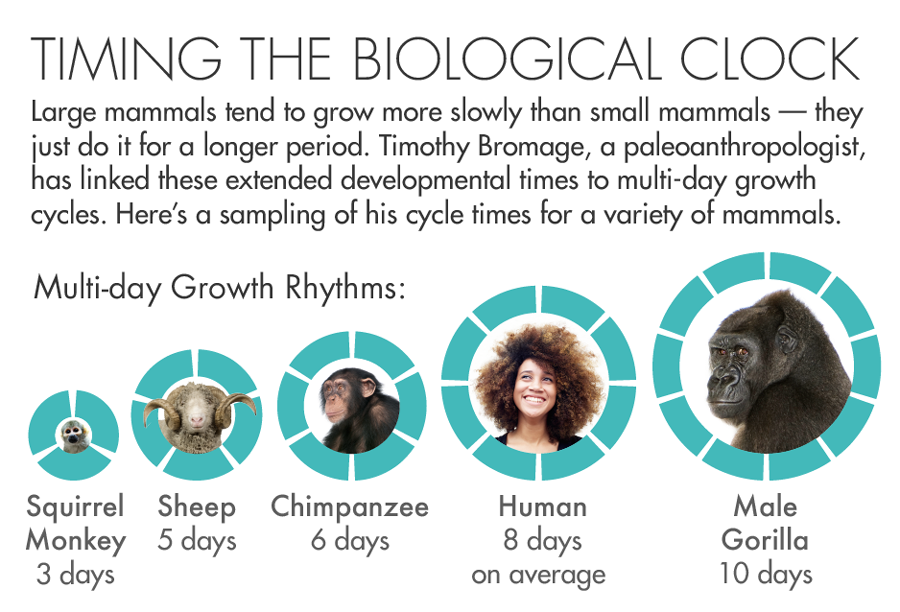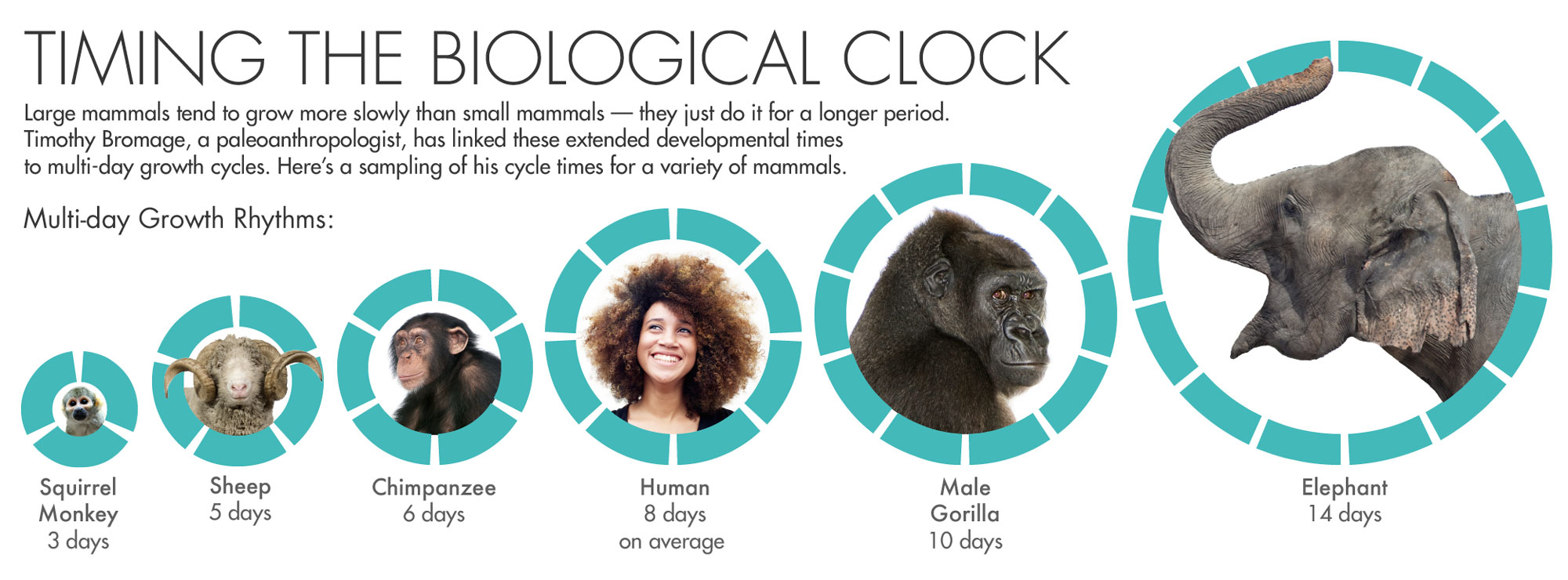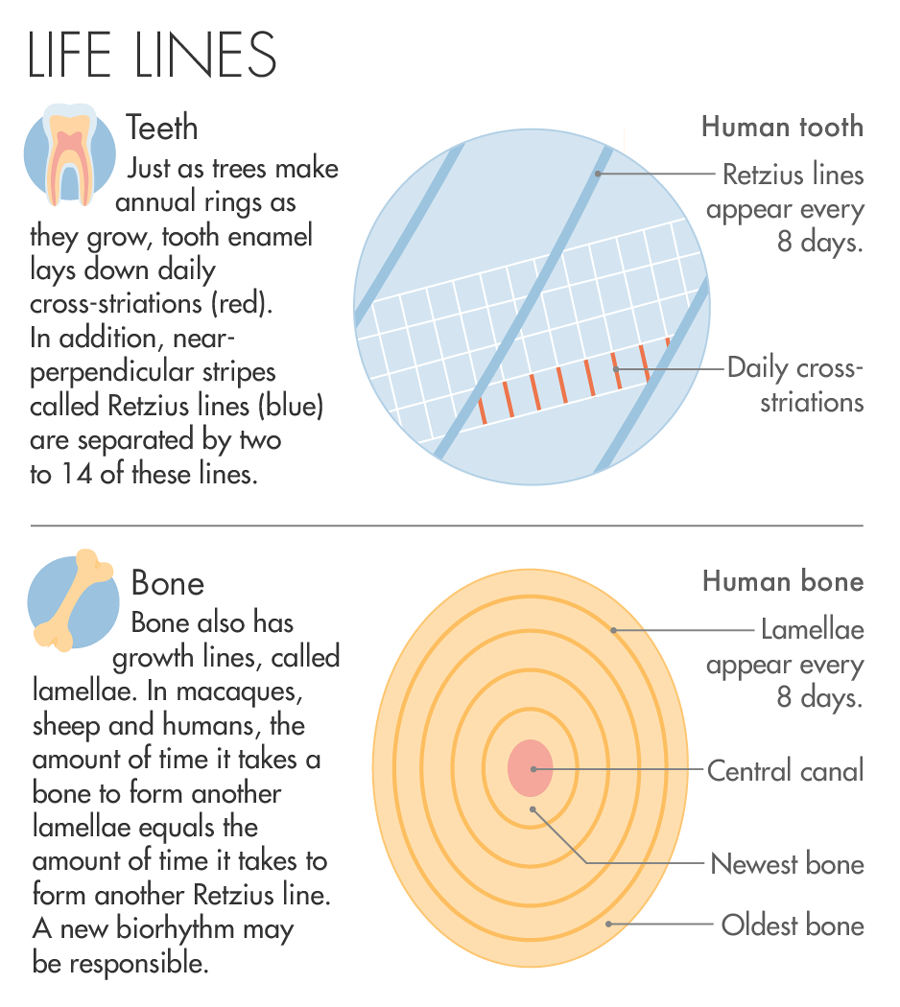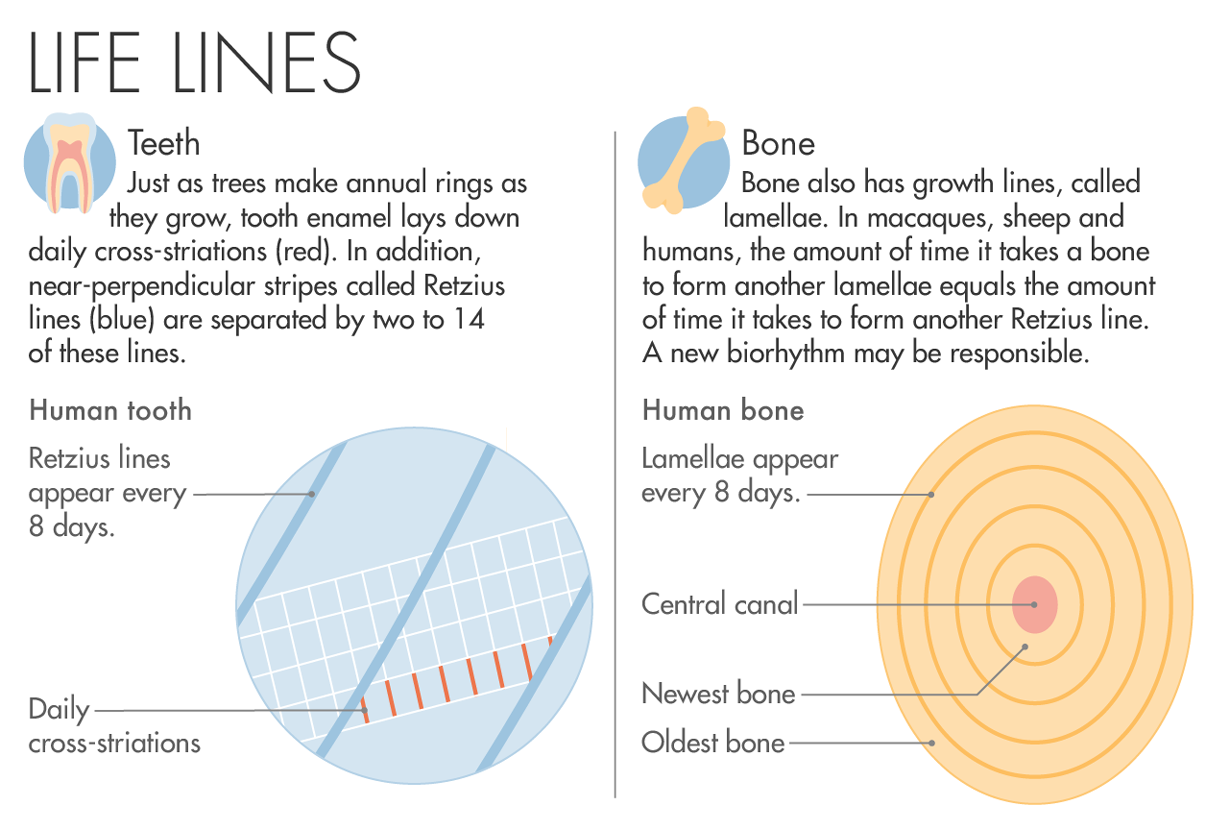Teeth May Reveal a Multi-Day Biological Clock

Olena Shmahalo/Quanta Magazine
Introduction
One summer day last year, Timothy Bromage, a paleoanthropologist at New York University, was chewing on a lollipop lamb chop while vacationing in Cyprus. Suddenly, he heard a pop. When a sharp pain followed, he realized he’d cracked a molar.
Back in New York, his dentist told him he’d have three hellish months if the tooth were repaired. “Or just give me five minutes,” the dentist said. “I’ll take it out right now.”
Bromage opted to have it taken out. That way, he could make a thin section from the tooth, something he’d wanted to do for years, to measure a new kind of biorhythm that he has been studying in the permanent teeth of mammals. This isn’t the well-studied circadian rhythm, but a longer one that varies, depending on the species, from two to 14 days. Bromage believes that it may set the pace for how quickly animals grow, and how long they live.
The biorhythm lasts for one day in rats; four days in macaques; five days in sheep; and six to 12 days in humans. Bromage has confirmed this relationship in dozens of other living and fossil mammalian species, including Asian elephants, which have a 14-day rhythm. (Exceptions exist: Dogs, for instance, don’t seem to follow the relationship.)
A generally slower rhythm in bigger mammalian species made sense: Bigger animals grow more slowly than smaller animals, just for longer periods. Bromage believes that the rhythm in teeth and bones reflects a growth signal to crank up the rate of cell division, one that the body’s tissues receive at regular intervals. The more often such signals are received, the faster the animal grows.
Not only does the rhythmic interval increase with body mass, but Bromage found that it also increases along with other features known to grow with body mass, like life span, lactation length, metabolic rate, length of the estrous cycle and even kidney size. This suggests that just by measuring the growth rhythm of one tooth, even from a fossil mammal, it may be possible to determine not only its body size but many other related features.
“Throw any tooth, any permanent tooth of a primate — just throw it at me, don’t even tell me what the primate is — and I’ll reconstruct their kidney size, lifespan, all of this stuff,” Bromage said. “It’s unbelievable what window of opportunity that material provides for understanding the key to life.”
After winning the prestigious Max Planck Research Prize with a colleague in 2010, he used the award of 750,000 euros to study if blood samples from animals reflect the same rhythms as tooth samples. The work has been expensive and time consuming — especially because mice and rats, the cheap work horses of biology, don’t have a multi-day rhythm and thus can’t be used.
His results, published early this year, aren’t yet strong enough to claim a discovery. And many chronobiologists remain skeptical.
Still, “What if he is right?” asked Robin Bernstein, a biological anthropologist at the University of Colorado, Boulder, who has studied body-size evolution and who now studies growth in humans and nonhuman primates. “I think he is one of those people that is ahead of his time,” she said. “This may pan out to be nothing, but it’s original, it’s really interesting, and I think there is a lot more to be done with it.”
The Bone Connection
Bromage became interested in teeth as a graduate student in the mid-1980s. At the time, researchers knew that just as trees make annual rings as they grow, tooth enamel lays down daily growth stripes. Japanese researchers had found them in the 1930s and 1940s in the teeth of dogs, rats, pigs and macaques.
Mammalian teeth also have conspicuous stripes called Retzius lines. In the early hominids Bromage was studying then, seven daily stripes separated each Retzius line. Nobody knew how or why they formed, but Bromage was able to use them as a marker to show that early hominids erupted their first permanent molars around age 3, the same age as chimpanzees — much younger than contemporary humans. This meant early hominids weren’t just miniature versions of contemporary humans, as was thought at the time, but more similar to apes.
In 1991, Bromage confirmed that the Retzius lines in macaques were only separated by four daily growth lines — not seven as he had seen in the early hominids. Then, in 2000, he realized that bones have a periodic growth pattern as well. He found that stripes, called lamellae, in rat bones grow in just one day. What puzzled him was that rat lamellae were just as thick as human lamellae. How could this be, given that human bones grow much more slowly than rat bones?
“For years and years and years this bugged me,” Bromage said. And then one day in 2008, he read in the Ph.D. thesis of one of his students that macaque bone lamellae take four days to grow — just like the Retzius lines he had seen in 1991 in macaque teeth. “That memory from 1991 flooded into my head the instant I saw that number four,” he recalled. Could it be, he wondered, that mammals have the same growth periods in bones and teeth? If that was the case, then human lamellae should take seven days to grow, much longer than the one day needed by rats.
Bromage called this idea “a completely new paradigm.” Until then, there was thought to be no connection between how bones and teeth grow; bones had never been considered a tissue that grows in incremental, measurable steps like teeth and trees. Any possible connection between the timing of tooth and bone growth was “so fundamental,” he said, “that I couldn’t say anything to anyone for an entire week,” not even his wife. He checked histological bone and teeth sections in his lab and found that indeed, bone and tooth growth rhythms were the same in macaques, sheep and humans.
The Brain’s Beat
If the rhythms Bromage saw in the growth stripes of mammalian teeth and bones were the response to a growth signal, where could that signal come from? Bromage believes its source is the same part of the brain that’s already known to generate the circadian rhythm, the hypothalamus. After all, he said, the length of the biorhythms he has studied is always multiples of whole days, and the circadian clock is already known to influence the cell division rate. The hypothalamus can do the job, so “why invent a whole new tool kit?,” he asked. Something, perhaps a substance that accumulates in the hypothalamus, might modulate the circadian clock on a multi-day cycle. Whatever it is in the brain that’s responsible, “all it has to do is count,” Bromage said.
The hypothalamus also fits in another way: It regulates the pituitary, a hormone gland whose front area regulates body size while the back regulates the length of estrous cycles. Perhaps not coincidentally, these are the only two physiological features that Bromage found to directly correlate with the length of the new biorhythm.
Bromage set out to test his theory. If a brain-generated signal regulates the pace of growth, Bromage reasoned, the blood should carry traces of this signal.


Lucy Reading-Ikkanda for Quanta Magazine; istock.com / Farinosa (spider monkey); GlobalP (sheep, chimpanzee, gorilla); m-imagephotography (human); najin (elephant)
Bromage spent two weeks collecting six-milliliter blood samples from pigs. He then shipped the 1,700 samples he had collected from 33 pigs to an independent laboratory to measure 995 different metabolites — biochemical substances produced by the body.
After spending $300,000, he had the answer: Of the 159 most highly concentrated metabolites with a known biological function, 108 showed a daily rhythm. The next-most-common rhythm was indeed the same five-day rhythm Bromage had found in the pigs’ teeth and bones. A total of 55 of the 159 metabolites cycled that way, whereas only 20 cycled with other rhythms.
To his surprise, he found two five-day cycles, each separated by three days. The first contained growth-related metabolites, while the second contained metabolites that form when biological molecules break down. This made sense: Once growth is over, metabolites need to be broken down so they become available for recycling in the next growth cycle. “What an elegant system,” Bromage said. “You would have never thought about it unless you saw it!”
He named the new biorhythm “Havers-Halberg Oscillation.” The name honors Clopton Havers, who in the late 17th century first described bone lamellae and what would later become known as Retzius stripes, and Franz Halberg, a chronobiologist at the University of Minnesota and a founding father of chronobiology, who died in 2013 at the age of 93.
The Problem With Pigs
In retrospect, naming the rhythm after Halberg may not have been the wisest choice.
Chronobiologists have become highly skeptical of claims of multi-day biorhythms, said Roberto Refinetti, a physiologist at Boise State University and the author of a text book on circadian physiology. That’s largely because of Halberg. In the early part of his career, Halberg was a pioneer of chronobiology. He even coined the word “circadian.” Yet later in life he claimed to see longer-period rhythms without much evidence. “He was really — he liked to say open minded,” Refinetti said. “Some people thought he was going beyond that.”
Refinetti has himself tried — and failed — to find a weekly rhythm in the blood pressure and the lactic acid concentration in the blood of horses. He thinks that the five-day rhythm in pigs that Bromage found might have been caused by the human work week, a relatively recent social invention. What’s more, he said, nothing in the environment could have guided a weekly rhythm to evolve over millions of years. Contrast this with the circadian rhythm, which obviously emerged in response to the day-night cycle.


Lucy Reading-Ikkanda for Quanta Magazine
Bromage countered that the rhythms he found are unlikely to be caused by the work week because the pigs were kept in constant conditions at all times. What’s more, the rhythms wouldn’t need a multi-day environmental cue to evolve if Bromage’s theory is correct: that they are based on the circadian clock, perhaps by counting it. Refinetti, he added, probably didn’t see a weekly rhythm in horses because he didn’t measure growth-related compounds.
As for the criticism of Halberg’s data, Bromage said he named the rhythm after him because Halberg “championed long-period rhythms when nobody else on the planet would.” That, said Bromage, doesn’t mean “I agree with everything he said.”
More challenging, perhaps, are statistical concerns with Bromage’s data. The cost and difficulty of the experiment forced it to be shorter than he would have liked. Because there were too few cycles, he couldn’t statistically check for rhythms in an unbiased way. Instead, the situation forced him to assume a five-day rhythm and then check whether that assumption is statistically significant. But if you want to claim a five-day cycle, you need to measure multiple cycles for statistical reasons, said Andrew Liu, a chronobiologist at the University of Memphis.
Bromage agreed that the experiment had shortcomings. “We were really pushing it,” he said. It would have been difficult to measure the pigs’ blood for a longer period: the animals became increasingly stressed and infections started to appear towards the end of the study. “It was a completely new experience for everybody, so it wasn’t done perfectly and we learned a lot,” Bromage said.
To get better data, he plans to include more cycles in his next study by measuring blood from rhesus macaques — which have a four-day rhythm — for a month. Macaques are trained to have their blood taken, he added, which will allow researchers to take samples from animals that don’t suffer the same stress-related problems as pigs.
Bromage noted that he had independently found a five-day rhythm in another type of molecule circulating in the pigs’ blood: small RNAs, and most of those with a five-day rhythm also have a growth-related biological function. He doesn’t believe that finding was a coincidence. “The chance of that happening is astronomically low,” he said.
The Two-Day Rat
Blood tests aren’t the only way that researchers can track rhythms. Liu, of the University of Memphis, said that if he had the money, he might want to look for a longer-term rhythm in a large animal by using a circadian reporter gene. Such genes are turned on by the circadian rhythm and produce a molecule that biologists can measure with high precision in real time. Hooking up such a gene to an animal’s hypothalamus might reveal that its circadian rhythm is somehow modulated on a multi-day schedule, Liu said. “This can be done,” he said, “I think it’s very intriguing.”
Yet even if the metabolite rhythm turns out to be real, Liu and others said, that doesn’t mean that it regulates body size. Rather, it might just reflect the different growth speeds in animals of different sizes. As Liu explained, “just because you see something in the blood with rhythms does not necessarily mean” it’s a cause.
Bromage agreed. “It’s just a hypothesis,” he said. “It’s testable.” To test it, he wants to expose cultured cells that are dividing once a day to biological factors that might turn the cells’ circadian rhythm into a multi-day rhythm. Once that works, he said, then researchers can see if they can turn a “whole rat into a two-day animal.”
This article was reprinted on TheAtlantic.com.



